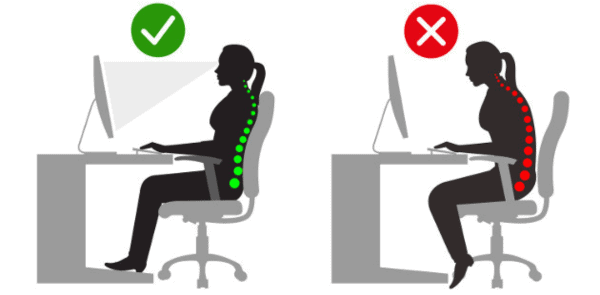Do you find yourself hunched over your desk or slumped in front of a screen? Then, later on, you experience back and neck pain after long hours of sitting. If yes, you’re not alone.
In today’s sedentary lifestyle, maintaining proper sitting posture is often overlooked. And this, mind you, can lead to a myriad of health issues. By making a conscious effort to correct your sitting posture, you can:
- alleviate discomfort
- improve your overall well-being
- boost productivity
In this blog, we will guide you through the steps to achieve optimal sitting posture. Say goodbye to slumping shoulders; hello to a more aligned and comfortable sitting!
The Importance of Good Posture
(Image Credit: Wikimedia Commons)
Maintaining a proper sitting posture works wonders for both your physical and mental well-being. To start, correct posture helps align your spine. This reduces the strain on your muscles, ligaments, and joints and promotes optimal blood circulation. Plus, it prevents the development of musculoskeletal imbalances and related discomfort.
Moreover, good posture enhances your respiratory function. This allows you to take deep, full breaths and supply your body with ample oxygen. In return, it boosts your energy levels, concentration, and cognitive performance.
On the flip side, prolonged poor posture can have detrimental effects on your health. Slumping or hunching forward can lead to muscle fatigue, tension, and pain. The particular targets are the neck, shoulders, and lower back. Over time, this can contribute to chronic conditions such as:
- cervical spondylosis
- lumbar disc degeneration
Additionally, poor posture can impact your digestion. This often causes issues like acid reflux and constipation. It may even affect your mood and self-confidence. A slouched posture, for one, is associated with feelings of low energy and decreased self-assurance.
Assessing Your Current Posture
 (Image Credit: Healthy Habit Studio)
(Image Credit: Healthy Habit Studio)
To assess your sitting posture, follow this step-by-step guide:
- Step 1: Sit in a chair with your feet flat on the floor and your back against the chair backrest.
- Step 2: Check if your knees are at a 90-degree angle, aligned with your hips. Avoid crossing your legs or tucking them under the chair.
- Step 3: Observe your spine. Ideally, it should maintain a natural S-shaped curve. The lower back should be slightly arched and the upper back straight.
- Step 4: Pay attention to your shoulders. They should be relaxed and level, not rounded or elevated.
- Step 5: Examine the position of your head. It should be aligned with your spine, avoiding excessive forward or backward tilting.
It also helps to be aware of these common posture mistakes:
- Sitting with a rounded back and shoulders forward places strain on the spine, a.k.a. slouching. This can lead to muscle imbalances.
- Crossing legs for extended periods disrupts proper alignment. It can affect blood circulation and potentially cause hip and lower back issues.
- Leaning excessively towards the desk strains the neck and upper back muscles. This can lead to discomfort and potential postural problems.
- Jutting the chin forward while sitting can strain the neck. Such a bad habit can contribute to neck pain and headaches.
Ergonomic Setup
 (Image Credit: Wallpaper Flare)
(Image Credit: Wallpaper Flare)
An ergonomic chair and desk setup play a role in maintaining a proper sitting posture. They are designed to support your body’s natural alignment, reducing strain. You can use an ergonomic chair back set support to do this.
To optimise your chair setup, adjust the seat height so that your feet rest flat on the floor or a footrest. Ensure your knees are at a 90-degree angle and aligned with your hips. Use the chair’s lumbar support to maintain the natural curve of your lower back. You can use a memory foam seat cushion to relieve any back pain.
For the desk setup, position it at a height that allows your elbows to rest comfortably. Ideally, it should be a 90-degree angle when typing. Adjust the monitor height so that the top of the screen is at or slightly below eye level. The distance should be about an arm’s length away.
Sitting Techniques for Good Posture
Maintaining a straight back and aligned spine is essential for good sitting posture. Sit towards the back of your chair, keeping your back straight and upright. Avoid slouching or rounding your shoulders forward.
- Feet: Keep both feet flat on the floor or a footrest, ensuring your knees are at a 90-degree angle. Avoid crossing your legs, as it can affect blood circulation and posture.
- Arms: Rest your arms comfortably on the desk or armrests of your chair, with your elbows bent at a 90-degree angle. Adjust the height of your chair or desk if necessary.
- Head: Position your head in alignment with your spine. Avoid leaning too far forward or backwards. Keep your chin parallel to the floor, with the top of your monitor at eye level, to avoid straining your neck.
By following these guidelines, you can achieve a balanced and aligned sitting posture.
Maintaining a Good Posture Throughout the Day
 (Image Credit: Wallpaper Flare)
(Image Credit: Wallpaper Flare)
Practice incorporating regular breaks and quick stretching exercises during prolonged sitting. Consider the following tips:
- Stand up and move around every 30 minutes to avoid prolonged static posture. Set reminders or use productivity tools to prompt you to take breaks
- Activate your core muscles by gently pulling your belly button towards your spine while sitting. This helps maintain stability and supports a proper sitting posture.
- Place a small cushion or lumbar roll behind your lower back. This helps provide support and reminds you to maintain proper posture.
Quick stretching exercises to ease stiffness:
- Neck rolls: Gently roll your neck in clockwise and counterclockwise motions. This helps release tension and stiffness in the neck and shoulders.
- Shoulder shrugs: Lift your shoulders towards your ears. Hold for a few seconds, and then release. Repeat this exercise a few times to relieve tension in the shoulders and upper back.
- Seated spinal twist: Sit tall, and place your right hand on the outside of your left thigh. Then, gently twist your torso to the left. Hold for a few seconds and repeat on the other side to relieve tension in the spine.
- Back stretches: Stretch out your spine with this back stretcher
Round-up
Proper sitting posture is a small change that can yield great benefits for your well-being. Remember, good posture goes beyond sitting. It influences your overall posture habits and impacts your long-term health. So, make a conscious effort to prioritise it. May you experience the positive impact it can have on your physical and mental well-being!


